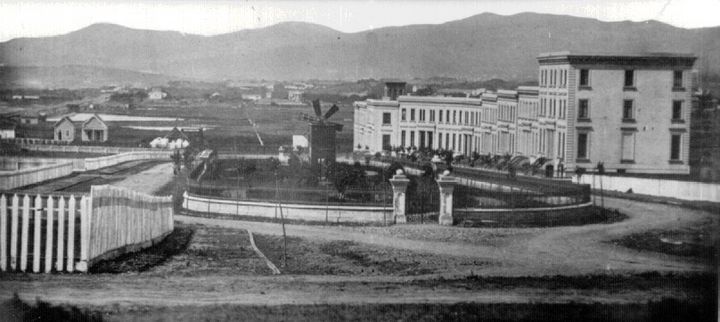South Park First Buildings: Difference between revisions
mNo edit summary |
m (Ccarlsson moved page South Park 1853 Westerly View to South Park First Buildings) |
||
| (9 intermediate revisions by the same user not shown) | |||
| Line 1: | Line 1: | ||
'''<font face = arial light> <font color = maroon> <font size = 3>Unfinished History</font></font> </font>''' | |||
'''South Park, 1853: San Francisco's first planned development, looking southwest from 2nd Street (Rincon Hill), Twin Peaks and Mt. Davidson in background.''' | [[Image:soma1$south-park-1853-photo.jpg|720px]] | ||
'''South Park, 1853: San Francisco's first planned development, looking southwest from 2nd Street (Rincon Hill), Twin Peaks and Mt. Davidson in background.''' | |||
''Photo: San Francisco History Center, San Francisco Public Library'' | |||
Built by capitalist George Gordon shortly after the gold rush, South Park was designed by George H. Goddard, Esq., an Englishman, and featured several lavish mansions around an "orchard." According to historian Albert Shumate, who assembled the book [http://www.printsoldandrare.com/windgatepress/page8.html ''South Park and Rincon Hill''] (Windgate Press), the oval shape was part of what was known as the "English Crescent Design," and was intended to promote neighborliness. | |||
[[Image:South Park. Ca. 1862. I0012522A.jpg]] | |||
'''The original development financed by George Gordon, stalled in this 1862 image.''' | |||
''Photo: Online Archive of California'' | |||
[[Image:South-Park-c-1890s.jpg]] | |||
'''Forty years later in the 1890s South Park had become a pleasant but forgotten urban park.''' | |||
''Photo: San Francisco History Center, San Francisco Public Library'' | ''Photo: San Francisco History Center, San Francisco Public Library'' | ||
[[SOUTH PARK|South Park and Rincon Hill continues]] | |||
[[Image: | [[Image:Tours-habitat.gif|link=Inner Sunset 1870s]] [[Inner Sunset 1870s|-->Open Space Habitat tour continues]] | ||
[[ | [[Harrison Street from Dunes to Trains|Prev. Document]] [[SOUTH PARK |Next Document]] | ||
[[category:SOMA]] [[category:real estate]] [[category:1850s]] | [[category:SOMA]] [[category:real estate]] [[category:1850s]] [[category:1860s]] [[category:buildings]] [[category:1890s]] | ||
Latest revision as of 13:32, 23 April 2021
Unfinished History
South Park, 1853: San Francisco's first planned development, looking southwest from 2nd Street (Rincon Hill), Twin Peaks and Mt. Davidson in background.
Photo: San Francisco History Center, San Francisco Public Library
Built by capitalist George Gordon shortly after the gold rush, South Park was designed by George H. Goddard, Esq., an Englishman, and featured several lavish mansions around an "orchard." According to historian Albert Shumate, who assembled the book South Park and Rincon Hill (Windgate Press), the oval shape was part of what was known as the "English Crescent Design," and was intended to promote neighborliness.
The original development financed by George Gordon, stalled in this 1862 image.
Photo: Online Archive of California
Forty years later in the 1890s South Park had become a pleasant but forgotten urban park.
Photo: San Francisco History Center, San Francisco Public Library
South Park and Rincon Hill continues



